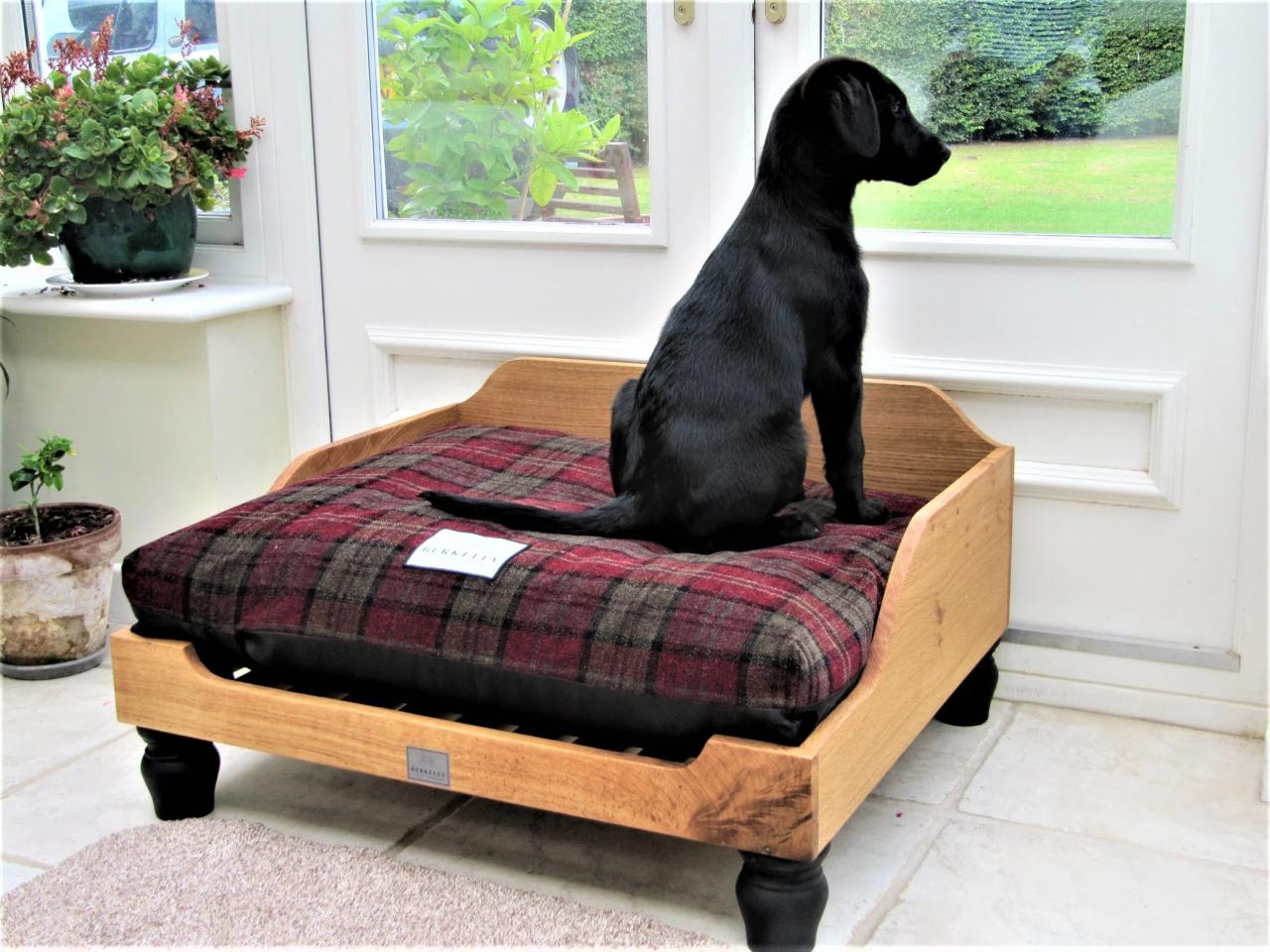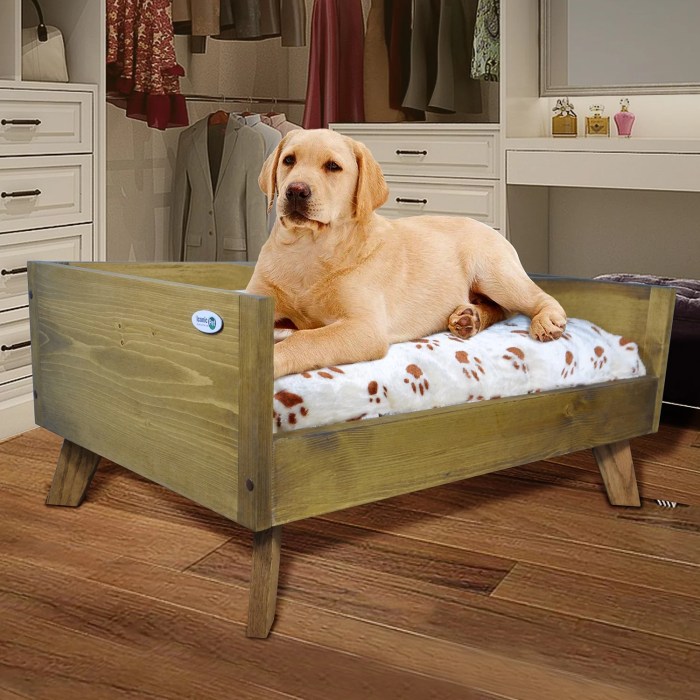Step into the world of dog beds, where comfort and well-being intertwine for our beloved furry companions. Dive into the diverse range of bed types, materials, sizes, and features to create the perfect sanctuary for your canine friend.
From orthopedic havens to cooling retreats, explore the benefits and drawbacks of each bed type, ensuring a restful slumber for your cherished pet. Delve into the materials that define each bed’s character, considering comfort, durability, and ease of cleaning. Let’s embark on this journey to find the ideal dog bed, tailored to your dog’s unique needs and preferences.
Dog Bed Types

When selecting a dog bed, there are several types to consider, each with its own advantages and disadvantages. The most common types include orthopedic, cooling, elevated, and more.
Orthopedic Dog Beds
Orthopedic dog beds are designed to provide support and comfort for dogs with joint pain or arthritis. They are typically made with memory foam or other supportive materials that conform to the dog’s body and help to distribute weight evenly.
Benefits of orthopedic dog beds include:
- Provides support and comfort for dogs with joint pain or arthritis
- Helps to distribute weight evenly
- Can improve sleep quality
Drawbacks of orthopedic dog beds include:
- Can be expensive
- May not be suitable for all dogs
Cooling Dog Beds
Cooling dog beds are designed to keep dogs cool and comfortable in hot weather. They are typically made with materials that absorb heat and moisture, such as gel or water-filled inserts.
Dog beds are an essential part of any pet owner’s home, providing a comfortable and supportive place for their furry friend to rest. When it comes to dog beds, there are many different options available, from simple foam beds to more luxurious models with orthopedic support.
For those who are looking for a high-quality dog bed that will provide their pet with the best possible sleep, the emma mattress is a great option. Made with premium materials and designed to provide optimal support and comfort, the emma mattress is sure to give your dog the best night’s sleep possible.
Benefits of cooling dog beds include:
- Keeps dogs cool and comfortable in hot weather
- Can help to prevent heatstroke
- Can be used indoors or outdoors
Drawbacks of cooling dog beds include:
- Can be expensive
- May not be suitable for all dogs
Elevated Dog Beds
Elevated dog beds are raised off the ground, which allows air to circulate around the dog and helps to keep them cool and comfortable. They are also a good option for dogs with joint pain or arthritis, as they reduce the amount of pressure on the dog’s joints.
Benefits of elevated dog beds include:
- Keeps dogs cool and comfortable
- Reduces pressure on the dog’s joints
- Can be used indoors or outdoors
Drawbacks of elevated dog beds include:
- Can be expensive
- May not be suitable for all dogs
Other Types of Dog Beds
In addition to the above, there are a number of other types of dog beds available, including:
- Cuddle beds: These beds are designed to provide a cozy and warm place for dogs to sleep.
- Donut beds: These beds have a raised edge that provides support for the dog’s head and neck.
- Bolster beds: These beds have a bolster around the edge that provides support for the dog’s body.
- Travel beds: These beds are designed to be portable and easy to transport, making them ideal for taking on trips.
Dog Bed Materials

When selecting a dog bed, the material is a crucial factor to consider. Different materials offer varying levels of comfort, durability, and ease of cleaning. Understanding the pros and cons of each material can help you make an informed decision that meets your dog’s specific needs.
Pampering your furry companion with a comfortable dog bed is a must, but don’t forget to keep their bedding fresh and inviting. For a touch of eco-friendly luxury, consider a bamboo quilt cover . Its breathable and hypoallergenic properties will keep your pup cozy and comfortable all night long.
And when it’s time for a refresh, simply throw it in the washing machine for easy cleaning, ensuring your dog’s bed stays as pristine as their wagging tail.
Memory Foam
- Advantages:Provides exceptional comfort and support, conforming to the dog’s body shape, reducing pressure points. Durable and retains its shape well over time.
- Disadvantages:Can be expensive, may trap heat, and is not as easy to clean as other materials.
Polyester
- Advantages:Affordable, durable, and easy to clean. Resistant to moisture and stains.
- Disadvantages:May not provide as much comfort as memory foam, can be less breathable.
Canvas
- Advantages:Durable, breathable, and easy to clean. Suitable for outdoor use and dogs that like to chew.
- Disadvantages:May not provide as much cushioning as other materials.
Faux Fur
- Advantages:Soft, cozy, and provides a sense of security for dogs. Can be machine-washed.
- Disadvantages:May not be as durable as other materials, can shed and attract dirt.
Best Materials for Different Dog Breeds and Needs
- Large breeds:Memory foam or orthopedic beds for comfort and support.
- Small breeds:Polyester or canvas beds for affordability and durability.
- Chewers:Canvas or ballistic nylon beds that can withstand chewing.
- Senior dogs:Memory foam or orthopedic beds for joint support and pain relief.
- Dogs with allergies:Hypoallergenic materials such as microfiber or cotton.
Dog Bed Sizes
Choosing the right size of dog bed is crucial for your pet’s comfort and well-being. Consider your dog’s breed, weight, and sleeping habits to determine the appropriate size.
Recommended Dog Bed Sizes
The following table provides recommended dog bed sizes for different breeds and weights:
| Breed | Weight (lbs) | Recommended Bed Size |
|---|---|---|
| Chihuahua | 2-6 | 18″ x 24″ |
| Beagle | 20-30 | 24″ x 36″ |
| Golden Retriever | 55-75 | 36″ x 48″ |
| Great Dane | 120-180 | 48″ x 72″ |
Dog Bed Features
Dog beds come with a variety of features that can enhance your dog’s comfort and well-being. These features range from practical elements like waterproof covers and non-slip bottoms to more luxurious amenities like built-in heating or cooling systems.
Waterproof Covers
Waterproof covers are an excellent choice for dogs who are prone to accidents or who enjoy spending time outdoors. They protect the bed from spills, drool, and other liquids, making it easy to clean and maintain. However, waterproof covers can trap heat and moisture, which may make them uncomfortable for dogs in warm climates.
Non-Slip Bottoms
Non-slip bottoms prevent the bed from sliding around on smooth surfaces, which can be especially important for older dogs or dogs with mobility issues. They also help to keep the bed in place when your dog is jumping on or off.
Built-in Heating or Cooling Systems, Dog beds
Built-in heating or cooling systems can provide your dog with additional comfort during extreme temperatures. Heating systems are ideal for cold climates, while cooling systems can help to keep your dog cool during hot summer days. However, these systems can be expensive and may require additional maintenance.
Dog beds are a must-have for any pet owner, providing a comfortable and cozy spot for their furry friend to rest. For added convenience and hygiene, consider a dog bed with removable cover . This allows for easy cleaning, ensuring a fresh and inviting bed for your beloved pet.
Dog beds come in various sizes and styles to suit different breeds and preferences, ensuring a perfect fit for every canine companion.
Comparison Table
The following table compares the features of different dog beds and their suitability for specific dog needs:
| Feature | Benefits | Drawbacks | Suitable for |
|---|---|---|---|
| Waterproof Cover | Protects bed from spills and liquids | Can trap heat and moisture | Dogs prone to accidents or who spend time outdoors |
| Non-Slip Bottom | Prevents bed from sliding | None | Older dogs or dogs with mobility issues |
| Built-in Heating System | Provides warmth during cold temperatures | Expensive, requires additional maintenance | Dogs in cold climates |
| Built-in Cooling System | Keeps dog cool during hot temperatures | Expensive, requires additional maintenance | Dogs in hot climates |
Dog Bed Care and Maintenance
Maintaining a clean and comfortable dog bed is crucial for your pet’s well-being and the hygiene of your home. Regular cleaning prevents bacteria and allergen buildup, ensuring a healthy and inviting sleeping environment for your furry friend.
Washing Dog Beds
The frequency of washing depends on the type of bed and your dog’s activity level. Generally, wash removable covers weekly and non-removable beds monthly.
- Check care instructions:Always refer to the manufacturer’s care label for specific washing instructions.
- Remove loose hair and debris:Use a vacuum cleaner or lint roller to remove excess hair and dirt before washing.
- Use a gentle detergent:Avoid harsh detergents that can irritate your dog’s skin. Choose a mild, pet-friendly detergent.
- Wash on a gentle cycle:Select the delicate or gentle cycle on your washing machine to prevent damage to the bed.
- Rinse thoroughly:Ensure all detergent residue is removed by rinsing the bed thoroughly.
Drying Dog Beds
Proper drying is essential to prevent mold and mildew growth.
- Tumble dry on low:If possible, tumble dry the bed on a low heat setting to prevent shrinkage or damage.
- Air dry:Hang the bed outdoors or in a well-ventilated area to air dry completely.
- Avoid direct sunlight:Prolonged exposure to direct sunlight can fade the bed’s fabric.
- Use a pet-safe disinfectant:Choose a disinfectant specifically designed for pet use, such as a 1:10 bleach solution.
- Spray or wipe the bed:Apply the disinfectant to the entire surface of the bed, including the inside and outside.
- Allow to air dry:Let the bed air dry completely before allowing your dog to use it.
- Rotate the bed:Use multiple beds or rotate their positions to prevent wear and tear in one specific area.
- Use a waterproof cover:Protect the bed from accidents and spills with a waterproof cover.
- Inspect regularly:Check the bed for any damage, such as tears or loose stitching, and repair them promptly.
Disinfecting Dog Beds
Disinfecting the bed periodically eliminates bacteria and viruses.
Extending the Lifespan of Dog Beds
With proper care, you can extend the lifespan of your dog’s bed.
Epilogue: Dog Beds

As we conclude our exploration of dog beds, remember that choosing the right bed is not merely a matter of aesthetics but a testament to your dog’s well-being. By considering their breed, size, and habits, you can create a haven where they can unwind, recharge, and dream in absolute comfort.
Embrace the joy of providing your furry friend with the gift of a restful sleep, ensuring their contentment and unwavering loyalty.
Frequently Asked Questions
What is the best type of dog bed for orthopedic support?
Orthopedic dog beds with memory foam or gel filling provide excellent support and pressure relief for dogs with joint pain or arthritis.
How often should I wash my dog’s bed?
Regular cleaning is essential to maintain hygiene and prevent bacteria buildup. Aim to wash your dog’s bed every 1-2 weeks, or more frequently if needed.
What size dog bed should I get for my puppy?
Consider your puppy’s adult size and choose a bed that will accommodate their growth. A bed that is too small can restrict their movement, while a bed that is too large may not provide adequate support.